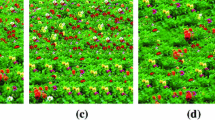Abstract
Image composition is widely used in television and film industry to create synthetic visual effects. It requires seamless integration of different parts of two or more images into a single image. Existing image composition techniques only change the local contents of the resulting image while in many cases local changes may also require some global effects as well. For example, if the image of sun from one image is transferred to another image, the global brightness pattern should also be transferred. Unfortunately existing techniques cannot handle global effects of local content manipulations. This paper describes a novel image composition technique which captures global effects associated with a specific local content from one image and incorporates in the second image. In our proposed technique, all images are transformed to the frequency domain. The composite image is created in frequency domain by mixing different frequencies from multiple images and then transformed back to the spatial domain. We have experimented the proposed technique to shift the image of sun along with its global brightness pattern, the global effects of rain and also for transferring global texture pattern from one image to the other. In most of the cases the results produced by our algorithm appear far close to real images than state of the art existing image composition techniques.





















Similar content being viewed by others
Notes
In the rest of the text term segment and content will be used interchangeably.
Source code is taken from author’s website: http://www.umiacs.umd.edu/~aagrawal/ICCV2007Course/index.html.
References
Adelson EH, Anderson CH, Bergen JR, Burt PJ, Ogden JM (1984) Pyramid methods in image processing. RCA Eng 29(6):33–41
Agarwala A, Dontcheva M, Agrawala M, Drucker S, Colburn A, Curless B, Salesin D, Cohen M (2004) Interactive digital photomontage. ACM Trans Graph 23:294–302. doi:10.1145/1015706.1015718
Arivazhagan S, Ganesan L, Subash Kumar T (2009) A modified statistical approach for image fusion using wavelet transform. Signal Image Video Process 3:137–144. doi:10.1007/s11760-008-0065-4
Boykov Y, Jolly MP (2001) Interactive graph cuts for optimal boundary amp; region segmentation of objects in n-d images. In: Proceedings of eighth IEEE international conference on computer vision, 2001, ICCV 2001, vol 1, pp 105–112. doi:10.1109/ICCV.2001.937505
Boykov Y, Veksler O, Zabih R (2001) Fast approximate energy minimization via graph cuts. IEEE Trans Pattern Anal Mach Intell 23:1222–1239. doi:10.1109/34.969114. http://portal.acm.org/citation.cfm?id=505471.505473
Farid M, Mahmood A (2012) Image morphing in frequency domain. J Math Imaging Vis 42:50–63. doi:10.1007/s10851-011-0273-3
Fattal R, Lischinski D, Werman M (2002) Gradient domain high dynamic range compression. ACM Trans Graph 21:249–256. http://doi.acm.org/10.1145/566654.566573
Flitti F, Collet C, Slezak E (2009) Image fusion based on pyramidal multiband multiresolution markovian analysis. Signal Image Video Process 3:275–289. doi:10.1007/s11760-008-0080-5
Goshtasby AA (2005) Fusion of multi-exposure images. Image Vis Comput 23:611–618. doi:10.1016/j.imavis.2005.02.004
Gracias N, Mahoor M, Negahdaripour S, Gleason A (2009) Fast image blending using watersheds and graph cuts. Image Vis Comput 27(5):597–607. The 17th British machine vision conference (BMVC 2006). doi:10.1016/j.imavis.2008.04.014. http://www.sciencedirect.om/science/carticle/pii/S0262885608001005
Graphics IC, Staff A (1994) Compositing, part 1: theory. IEEE Comput Graph Appl 14:83–87. doi:10.1109/38.310740. http://portal.acm.org/citation.cfm?id=616032.617920
Haenselmann T, Busse M, Kopf S, King T, Effelsberg W (2009) Multi perspective panoramic imaging. Image Vis Comput 27(4):391–401. doi:10.1016/j.imavis.2008.06.008. http://www.sciencedirect.com/science/article/pii/S0262885608001303
Jia J, Sun J, Tang CK, Shum HY (2006) Drag-and-drop pasting. ACM Trans Graph 25:631–637. http://doi.acm.org/10.1145/1141911.1141934
Levin A, Zomet A, Peleg S, Weiss Y (2003) Seamless image stitching in the gradient domain. In: Eighth European conference on computer vision (ECCV 2004). Springer, pp 377–389
Pérez P, Gangnet M, Blake A (2003) Poisson image editing. ACM Trans Graph 22:313–318. http://doi.acm.org/10.1145/882262.882269
Porter T, Duff T (1984) Compositing digital images. SIGGRAPH Comput Graph 18:253–259. http://doi.acm.org/10.1145/964965.808606
Rother C, Kolmogorov V, Blake A (2004) “Grabcut”: interactive foreground extraction using iterated graph cuts. ACM Trans Graph 23:309–314. http://doi.acm.org/10.1145/1015706.1015720
Suo J, Lin L, Shan S, Chen X, Gao W (2011) High-resolution face fusion for gender conversion. IEEE Trans Syst Man Cybern, Part A, Syst Humans 41(2):226–237. doi:10.1109/TSMCA.2010.2064304
Szeliski R (2006) Image alignment and stitching: a tutorial. Found Trends Comput Graph Vis 2:1–104. doi:10.1561/0600000009. http://portal.acm.org/citation.cfm?id=1295184.1295185
Toet A (1990) Hierarchical image fusion. Mach Vis Appl 3:1–11. doi:10.1007/BF01211447
Toet A, van Ruyven JJ, Valeton J (1989) Merging thermal and visual images by a contrast pyramid. Opt Eng 14:789–792
Wallace BA (1981) Merging and transformation of raster images for cartoon animation. SIGGRAPH Comput Graph 15:253–262. http://doi.acm.org/10.1145/965161.806813
Yang W, Zheng J, Cai J, Rahardja S, Chen CW (2009) Natural and seamless image composition with color control. Trans Img Proc 18(11):2584–2592
Zhang Q, Wang L, Li H, Ma Z (2011) Similarity-based multimodality image fusion with shiftable complex directional pyramid. Pattern Recogn Lett 32:1544–1553. doi:10.1016/j.patrec.2011.06.002
Author information
Authors and Affiliations
Corresponding author
Rights and permissions
About this article
Cite this article
Farid, M.S., Mahmood, A. An image composition algorithm for handling global visual effects. Multimed Tools Appl 71, 1699–1716 (2014). https://doi.org/10.1007/s11042-012-1303-x
Published:
Issue Date:
DOI: https://doi.org/10.1007/s11042-012-1303-x




